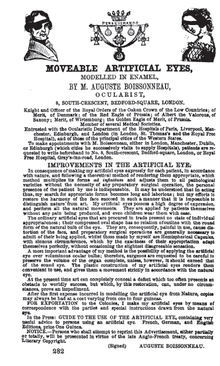
Auguste Boissonneau (26 July 1802, Saumur – 7 July 1883, Paris) was a French ornithologist and ocularist. In the latter field he was a pioneer of ocular prosthesis.[1]
As an ornithologist, he was the taxonomic authority of numerous species native to tropical and subtropical South America. The hummingbird genus Boissonneaua (Reichenbach, 1854) commemorates his name, as does the species Pseudocolaptes boissonneautii (streaked tuftedcheek), a bird circumscribed by Frédéric de Lafresnaye in 1840.[2]
Ornithological taxa described by Boissonneau
[edit]- Black-chested mountain tanager - Cnemathraupis eximia.
- Blue-and-black tanager - Tangara vassorii.
- Blue cotinga - Cotinga nattererii.
- Bronze-tailed thornbill - Chalcostigma heteropogon.
- Buff-breasted mountain tanager - Dubusia taeniata.
- Collared inca - Coeligena torquata.
- Colombian mountain grackle - Macroagelaius subalaris.
- Crimson-mantled woodpecker - Piculus rivolii.
- Glossy flowerpiercer - Diglossa lafresnayii.
- Green-and-black fruiteater - Pipreola riefferii.
- Green-bearded helmetcrest - Oxypogon guerinii.
- Golden-bellied starfrontlet - Coeligena bonapartei.
- Golden-fronted whitestart- Myioborus ornatus.
- Grey-browed brush finch - Arremon assimilis.
- Metallic-green tanager - Tangara labradorides.
- Mountain velvetbreast - Lafresnaya lafresnayi.
- Moustached brush finch - Atlapetes albofrenatus.
- Pale-naped brush finch - Atlapetes pallidinucha.
- Purple-backed thornbill - Ramphomicron microrhynchum.
- Slaty brush finch - Atlapetes schistaceus.
- Smoky bush tyrant - Myiotheretes fumigatus.
- Sword-billed hummingbird - Ensifera ensifera
- White-throated toucanet - Aulacorhynchus albivitta.[3]
Partial bibliography
[edit]- Nouvelles espèces d'Oiseaux-Mouches de Santa-Fé de Bogota, Revue zoologique la Société cuviérienne, 1839, S. 354–356.
- Oiseaux nouveaux ou peu connus de Santa-Fé de Bogota, Revue zoologique la Société cuviérienne, 1840, S. 2–8.
- Nouvelle espèce du genre Pic, Revue zoologique la Société cuviérienne, 1840, S. 36–37
- Oiseaux nouveaux de Santa-Fé de Bogota, Revue zoologique la Société cuviérienne, 1840, S. 66–71.
- Recherche sur l'histoire des yeux artifisiels, Annales de la Société de médecine de Gand, 1843.
- Prothèse oculaire. Yeux artificiels mobiles de M. Boissonneau, 1849.
- "Methode of complete and individual appropriation of artificial eyes comprising the different kinds of advertissements, with the wood cuts belonging to them. M. Auguste Boissonneau's moveable artificial eyes..." W. T. Soulby, 1853.
- De la Restauration de la physionomie chez les personnes privées d'un oeil, 1859.[4][5]
References
[edit]- ^ Chronological and Descriptive Index of Patents Applied for and Patents ... Great Britain. Patent Office
- ^ The Eponym Dictionary of Birds by Bo Beolens, Michael Watkins, Michael Grayson
- ^ ITIS Taxon author: Boissonneau, 1840
- ^ Catalogue of Scientific Papers (1800-1900): ser. 1 , 1800-1863 by Royal Society (Great Britain), Henry White, Herbert McLeod, Henry Forster Morley
- ^ Google Search List of published works.
Well, that’s interesting to know that Psilotum nudum are known as whisk ferns. Psilotum nudum is the commoner species of the two. While the P. flaccidum is a rare species and is found in the tropical islands. Both the species are usually epiphytic in habit and grow upon tree ferns. These species may also be terrestrial and grow in humus or in the crevices of the rocks.
View the detailed Guide of Psilotum nudum: Detailed Study Of Psilotum Nudum (Whisk Fern), Classification, Anatomy, Reproduction